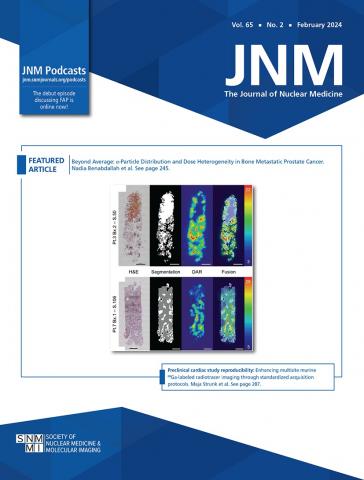18F-FDOPA PET/CT上的高肿瘤摄取表明转移性中肠神经内分泌肿瘤患者的预后较差:来自肿瘤内分泌组和内分泌网络的一项研究。
IF 9.1
1区 医学
Q1 RADIOLOGY, NUCLEAR MEDICINE & MEDICAL IMAGING
Journal of Nuclear Medicine
Pub Date : 2023-11-01
Epub Date: 2023-08-31
DOI:10.2967/jnumed.123.265584
引用次数: 0
摘要
6-18F-FDOPA的PET/CT对中肠神经内分泌肿瘤有较高的诊断价值。我们探讨了18F-FDOPA PET/CT摄取在转移性中肠NETs中的预后作用。方法:我们在一个测试队列(n=166)和一个完整的外部验证队列(n=86)中纳入了2010年至2021年在5个专家中心接受18F-FDOPA PET/CT的所有连续的转移性中肠NETs患者。我们在每次18F-FDOPA PET/CT扫描中测量了肿瘤和非肿瘤肝脏的最大摄取量(SUVmax和SUVpeak)。我们在测试队列中使用Kaplan-Meier和多变量Cox比例风险分析测量了PET/CT时的总生存率(OS),并在验证队列中进行了复制,评估了预后因素。结果:两组患者的特征相似。在试验队列中,中位随访为60.3 mo.SUV峰值肿瘤与肝脏(T/L)比率大于4.2的患者的生存期明显短于比率为4.2或更低的患者(P=0.01),5-y OS率分别为74.1%±4.5%和95%±3.4%。在多变量分析中,在调整了年龄、级别、先前行数、转移部位数和类癌综合征的存在后,SUVpeak T/L比值超过4.2仍与较短的OS相关(危险比,2.30;95%CI,1.02-5.22;P=0.046)。在验证队列中,SUVpeak T/L比率≤4.2或>4.2的患者的5-y OS发生率分别为100%和57.8%±12.5%(P=0.075)。随着时间的推移,SUV峰值T/L比率的增加往往会对预后产生不利影响。结论:18F-FDOPA PET/CT对肿瘤的摄取是转移性中肠NETs患者的独立预后因素。本文章由计算机程序翻译,如有差异,请以英文原文为准。
High Tumor Uptake on 18F-FDOPA PET/CT Indicates Poor Prognosis in Patients with Metastatic Midgut Neuroendocrine Tumors: A Study from the Groupe d'étude des Tumeurs Endocrines and ENDOCAN-RENATEN Network.
Visual Abstract PET/CT with 6-18F-fluoro-l-dopa (18F-FDOPA) has high diagnostic performance for midgut neuroendocrine tumors (NETs). We explored the prognostic role of 18F-FDOPA PET/CT uptake in metastatic midgut NETs. Methods: We included, in a test cohort (n = 166) and a full external validation cohort (n = 86), all consecutive patients with metastatic midgut NETs who underwent 18F-FDOPA PET/CT in 5 expert centers from 2010 to 2021. We measured the maximal uptake (SUVmax and SUVpeak) of the tumor and nontumor liver on each 18F-FDOPA PET/CT scan. We measured overall survival (OS) from the time of PET/CT and assessed prognostic factors using Kaplan–Meier and multivariable Cox proportional-hazards analyses in the test cohort, with replication in the validation cohort. Results: Patients had similar characteristics in both cohorts. In the test cohort, median follow-up was 60.3 mo. Patients with an SUVpeak tumor-to-liver (T/L) ratio of more than 4.2 had significantly shorter survival than those with a ratio of 4.2 or less (P = 0.01), with a 5-y OS rate of 74.1% ± 4.5% versus 95% ± 3.4%, respectively. On multivariable analysis, an SUVpeak T/L ratio of more than 4.2 remained associated with shorter OS (hazard ratio, 2.30; 95% CI, 1.02–5.22; P = 0.046) after adjustment for age, grade, number of previous lines, number of metastatic sites, and presence of carcinoid syndrome. In the validation cohort, the 5-y OS rate was 100% versus 57.8% ± 12.5% in patients with an SUVpeak T/L ratio ≤ 4.2 or > 4.2, respectively (P = 0.075). An increasing SUVpeak T/L ratio over time tended to have a pejorative prognostic impact. Conclusion: Tumor uptake on 18F-FDOPA PET/CT is an independent prognostic factor in patients with metastatic midgut NETs.
求助全文
通过发布文献求助,成功后即可免费获取论文全文。
去求助
来源期刊

Journal of Nuclear Medicine
医学-核医学
CiteScore
13.00
自引率
8.60%
发文量
340
审稿时长
1 months
期刊介绍:
The Journal of Nuclear Medicine (JNM), self-published by the Society of Nuclear Medicine and Molecular Imaging (SNMMI), provides readers worldwide with clinical and basic science investigations, continuing education articles, reviews, employment opportunities, and updates on practice and research. In the 2022 Journal Citation Reports (released in June 2023), JNM ranked sixth in impact among 203 medical journals worldwide in the radiology, nuclear medicine, and medical imaging category.
 求助内容:
求助内容: 应助结果提醒方式:
应助结果提醒方式:


